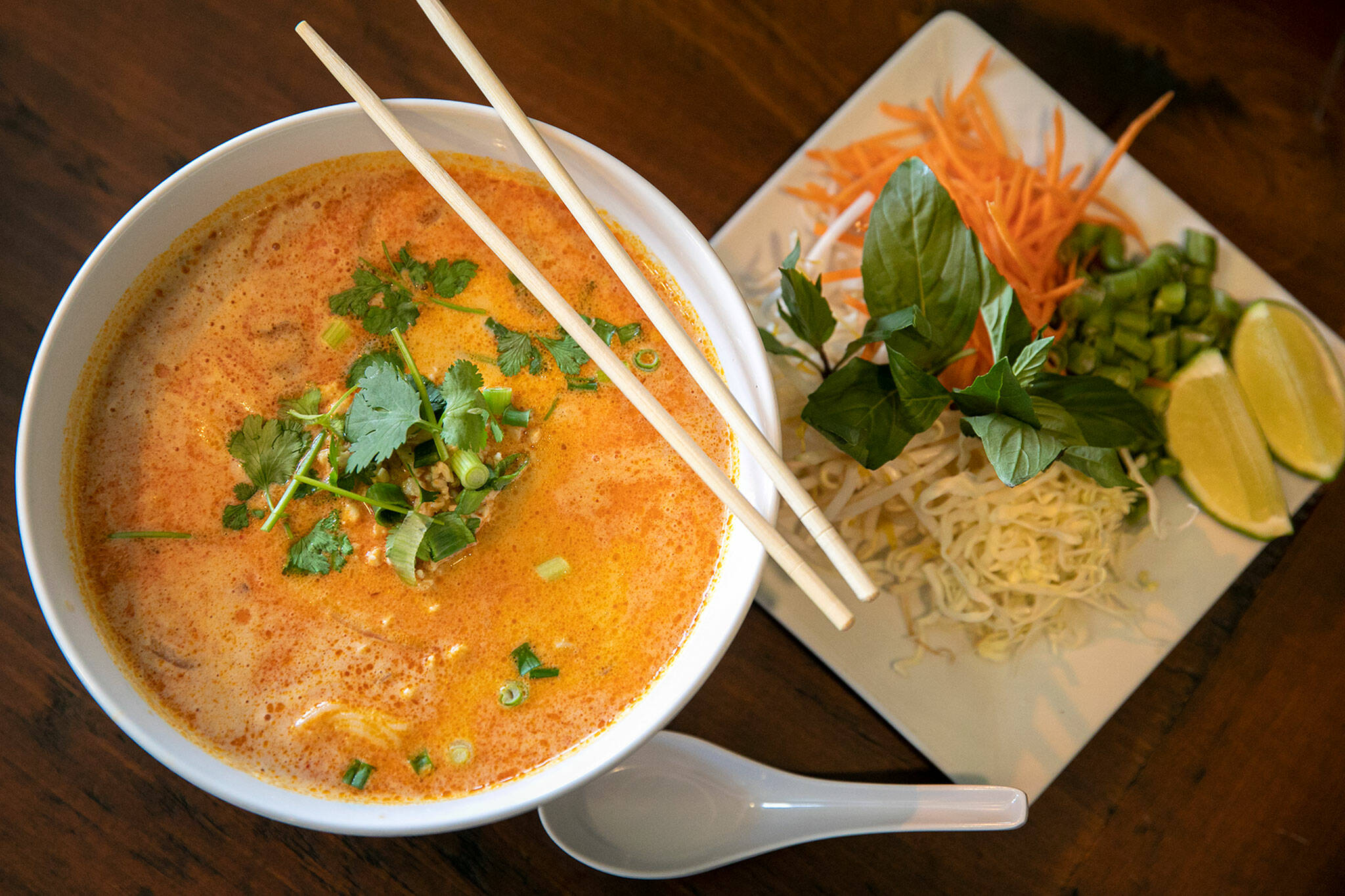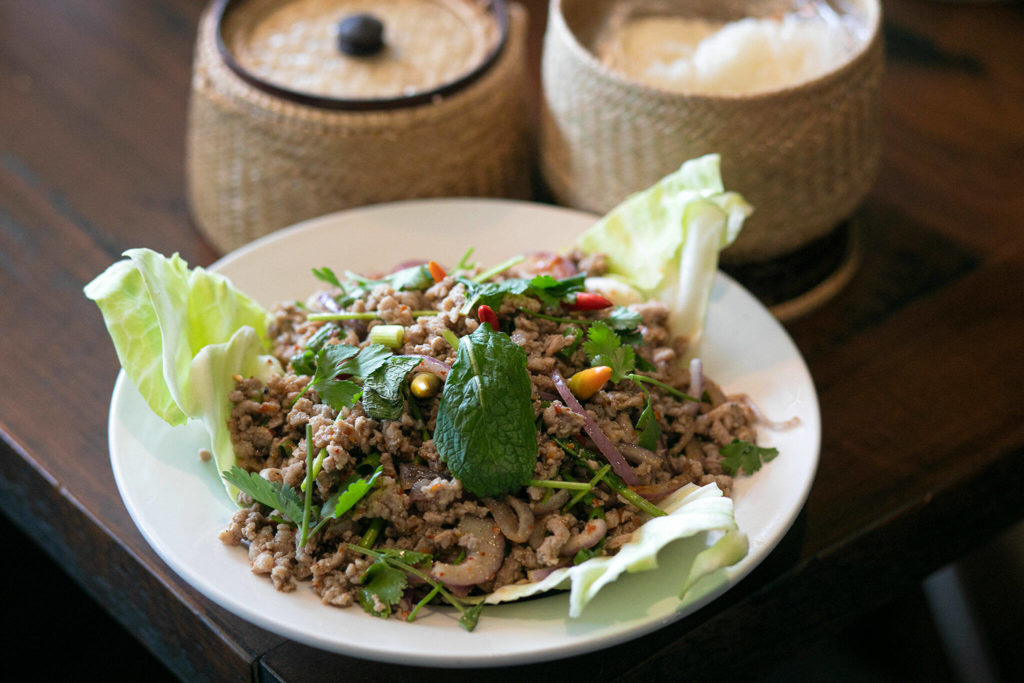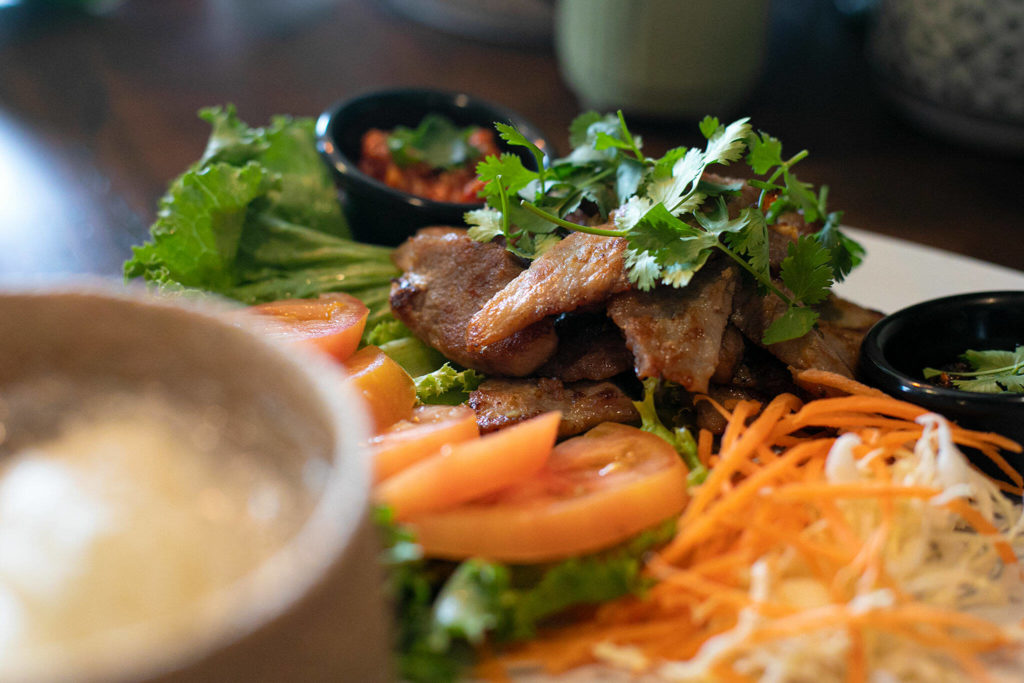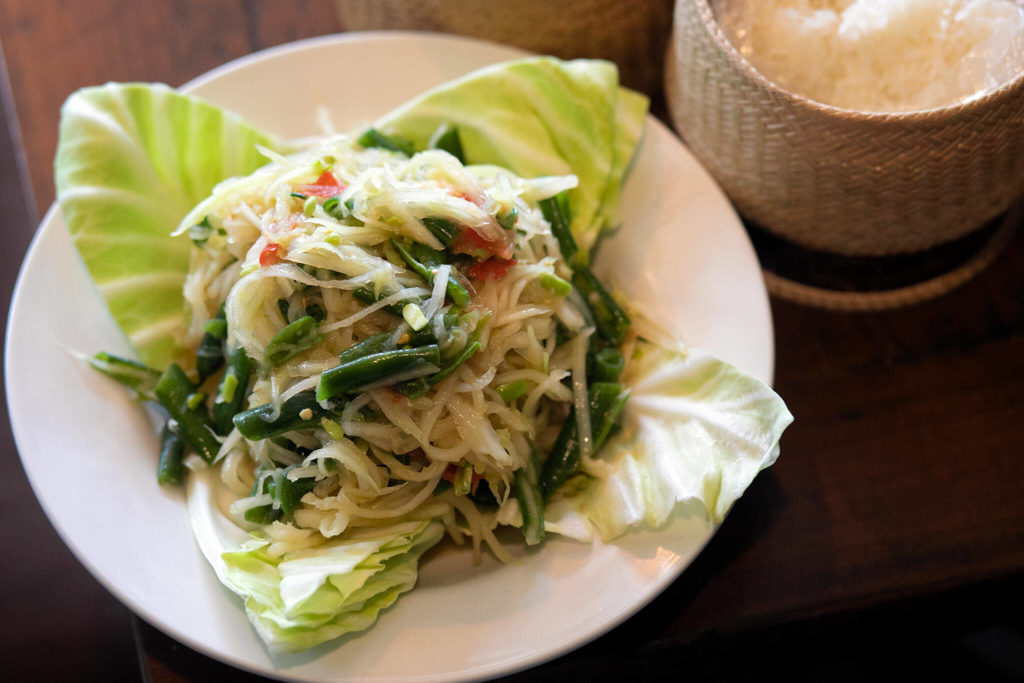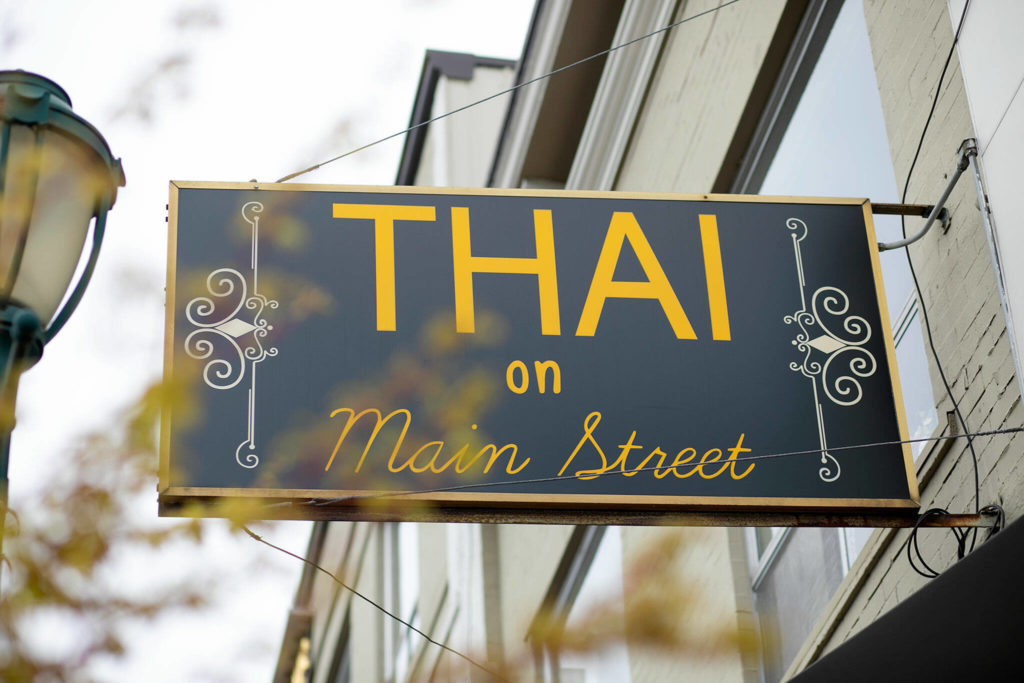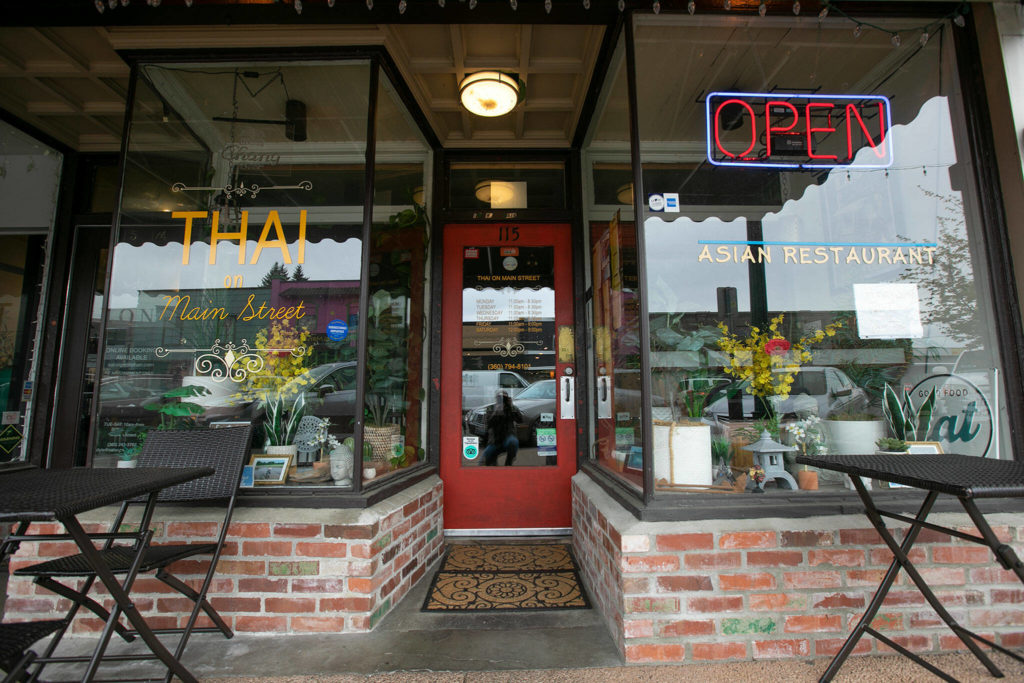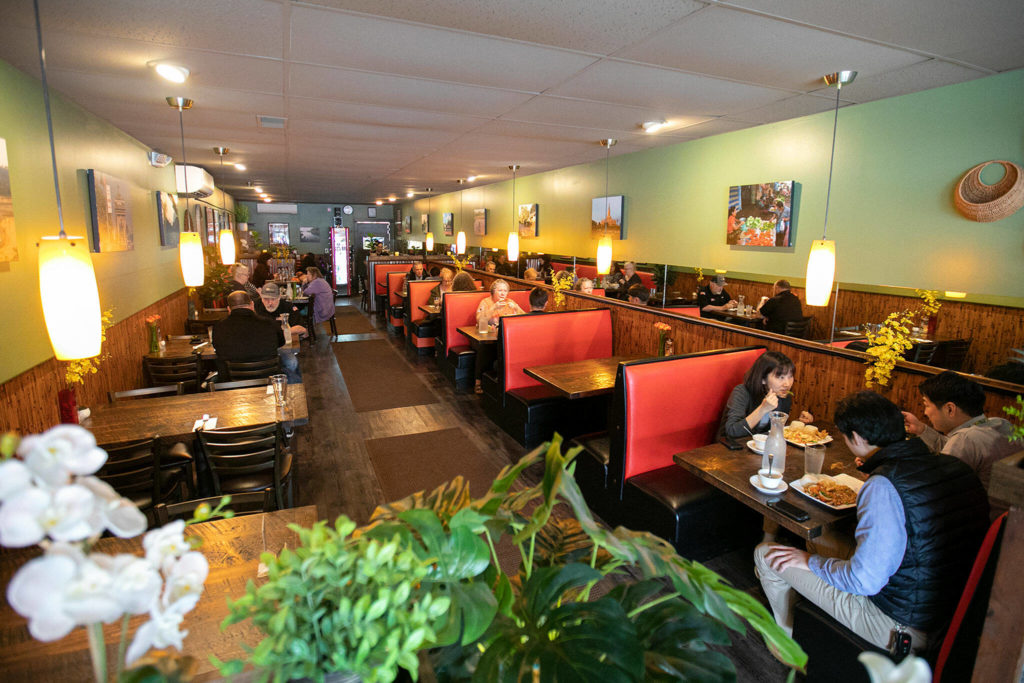MONROE — Bousa Inthapanya is introducing people to his home country — one spicy, herbaceous helping of pork salad and sticky rice at a time.
When it comes to southeast Asian restaurants in Snohomish County (and much of the United States), Vietnamese and Thai are among the most popular, with slurpable favorites like pho and pad thai.
But dishes from Laos, a landlocked country sandwiched between Thailand and Vietnam, are far less known.
Thai on Main Street is trying to change that. The Monroe restaurant serves up Lao dishes like laab ($12 to $14), a minced meat salad mixed with nutty toasted rice powder, lime, green onion, cilantro and mint.
Lao dishes are colorful and vibrant, earthy and savory and bitter. They’re often made with both fresh and fermented ingredients. At Thai on Main Street, you’ll get crunch from both raw vegetables and fried chicken. You’ll learn to eat with your hands, strengthen your jawline via a lightly fried beef jerky dish called seen lot, catch pungent whiffs of a popular fish condiment, tearfully question your five-chili spice level, revel in the impressive herb-to-meat ratio, and find yourself coming back for more.
“People who have never tried Lao food want to ease their way in, so we start them out with something familiar, like laab, which is on a lot of Thai menus,” said Amy Inthapanya, co-owner of Thai on Main Street and Bousa’s wife. “When they try the Lao version, they’re blown away with how different it is. It’s got some funk to it.”
Laos has fewer noodle dishes than Thailand, but one of Thai on Main Street’s most popular Lao dishes is an aromatic curry noodle soup called khao poon katee ($14), infused with sinus-clearing lemongrass, kaffir lime, galangal and chili. Amy’s father and co-owner Tim Jurkovich joked that the soup “could cure COVID.”
“I always say it’s like a marriage between pho and curry,” Amy said.
Amy often posts educational (and delicious) content on the restaurant’s Facebook page, introducing followers to Thai and Lao dishes. She also shares photos of the two countries.
“I try to bring more attention to the Lao menu and Lao culture,” she said. “It is so underrepresented and unknown still.”
Lao dishes are a labor of love: The meat in the laab is minced in-house, and for the green papaya salad ($12), Bousa and his fellow chefs hack, shred and pound the unripe fruit in a large mortar and pestle with garlic, cherry tomatoes, carrots and green beans. Bruising the papaya allows it to soak in a savory sauce made with padaek. This fermented fish sauce wakes up your umami taste receptors (and nostrils), adding a deep flavor that distinguishes some Lao dishes from their Thai counterparts.
If you find yourself at Thai on Main Street (or a street market in Laos,) you’ll likely find (and order) smoky grilled meats, savory omelets, seen lot and green bean salad. Be sure to order a side of dipping sauce: the jeow mak len (roasted tomato and garlic) and jeow bong (lightly spiced, savory sweet chili) are both excellent. All of the above are meant to be scooped up with sticky rice. Just know that if you try to eat sticky rice with a fork, you’ll be met with both defeat and the triumphant realization that hands and glutinous grains make the best utensils.
If padaek is the lifeblood of Lao cuisine, then sticky rice is the connective tissue. Lao people often refer to themselves as luk khao niaow: “children of sticky rice.”
“Because no matter where Lao people are in the world, sticky rice holds them together,” Amy said.
Despite their popularity in Thai restaurants, dishes like laab and green papaya salad may have originated in Laos, according to some food historians.
“History plays a big part,” Amy said. “Thailand has a huge resource of culinary schools where they would train chefs to come over to the U.S., and they got grants to start restaurants.”
After the Vietnam War, many Laotians came to the United States as refugees with few resources, whereas Thai immigrants generally had more money and culinary training to start their own businesses.
“I think that’s part of the reason why Lao food has stayed under the radar for so long,” she added.
Compared to Lao dishes, Thai cuisine is known for longer cooking periods: simmering curries, boiled vegetables. Without refrigeration came preservation methods that now define Lao cuisine: fermentation, dehydration, pickling. Lao dishes are also marked by the country’s landlocked geography: Without ocean access, Laotians make padaek from fish along the Mekong River.
“It sticks to its roots,” Jurkovich said of Lao cuisine. “It’s what was available out in the countryside. You gather the herbs and grasses and rice.”
At Thai on Main Street, you can choose your preferred spice level on any dish: “On the record, it’s up to five stars, but off the record, the sky’s the limit,” Amy said. The other day, Bousa made laab for their seven-year-old daughter.
“He didn’t tell us he put minced chilis in there,” Amy said as Bousa laughed next to her. “She was eating it and she was like, ‘It’s a little spicy! But it’s good.’”
These dishes are what Bousa grew up eating. His family lived on a sticky rice farm in Vientiane province (you’ll find some photos of the family farm and a nearby temple on the restaurant’s calming green walls). There, he learned how to make sticky rice and began cooking when he was eight: “So I feel like I’ve been a chef for 30 years,” he said, laughing.
He and Amy met in Laos while both were working for the Ministry of Information and Culture. He worked in radio and she wrote for a magazine. They fell in love, moved to the United States in 2006, got married and settled in Washington.
Bousa worked as a chef in Lake Stevens but often dreamed of owning his own restaurant. So during the pandemic, the couple took over Thai on Main Street. They made the best of Washington’s takeout-only phase, renovating the restaurant and expanding the existing menu with more Thai dishes. They also built an entire menu dedicated to Lao food. (As I write this, they are adding more Lao items to the menu.)
“Several people have come in who traveled and spent time in Southeast Asia, and they say, ‘Oh man, I haven’t had real Lao food since I was in Laos,’” Jurkovich said. “It’s really gratifying.”
If you go
Thai on Main Street
115 W Main St, Monroe
Questions/Reservations: 360-794-8101
Website: thaionmainstreet.com
Tip: For Lao eats in southern Snohomish County, I’ve heard great things about Sabai Sabai Lao & Thai Cuisine in Lynnwood, where you can find soop nor mai (shredded bamboo shoots cooked with yanang leaf extract, herbs and spices), sai qoua (pork sausages), sakoo yat sai (pork-stuffed tapioca balls) and other traditional dishes.
Talk to us
> Give us your news tips.
> Send us a letter to the editor.
> More Herald contact information.
